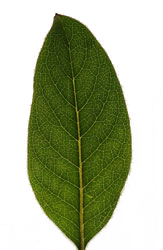Classifying leaves
0
Overview
Using this Resource
Connecting to the Curriculum
Marking Student Responses
Working with Students
Further Resources
One of the ways scientists classify or group plants, is to look at ways the leaves of plants are the same. Some of the things they look at are:
- the shape of the leaf
- the vein pattern
- whether the edge of the leaf is smooth or spikey
- whether there is one leaf or more than one leaf branching from the stalk.
Task administration:
This task can be completed online with SOME auto-marking.
Level:
3
Curriculum info:
Key Competencies:
Keywords:
Description of task:
Task: Look for the similarities and differences in leaf patterns to answer questions about observations and evidence.
Curriculum Links:
Science capabilities
The capabilities focus is brought about by the conversations students have and the questions they ask.
Capability: Gather & interpret data
This resource provides opportunities for students to discuss the data/evidence they collect and the patterns they notice in order to answer a question about classification and/or identification.
Science capability: Gather and interpret data (Tāhūrangi)
Capability: Critique evidence
This resource provides opportunities to discuss whether the data gathered provides evidence for the conclusions drawn.
Science capability: Critique evidence (Tāhūrangi)
Science capabilities:
Answers/responses:
| Questions | Student responses |
| a) Choose two leaves that have the same smooth edge. |
  |
| b) Choose two leaves that have the same vein pattern. |
Any two of:
|
| Explain how the vein pattern is the same in the two leaves you chose. |
Accept any explanation that students can observe from the pictures.
Students might look at more than one aspect/similarity: a more detailed explanation, e.g.,
They may also include comparison, e.g.,
and/or measurement, e.g.,
or
Students might look at one similarity: a simple explanation, e.g.,
|
| c) i) Are the answers Moana gave correct? Explain why you think this. |
No [as both reasons are incorrect].
Explanation:
|
|
c) ii) Has Moana left out any other reasons why they are the same? Yes/No
Explain why you think this.
|
Yes
Explanation:
|
Teaching and learning:
This key ideas in this task are about making precise observations and critiquing evidence.
Diagnostic and formative information:
| Questions | Student explanations |
|
b) Explain how the vein pattern is the same in the two leaves you chose. |
When looking for patterns in data, it is important to have precision and as much evidence as possible to support the statements/conclusions made. In this resource, some students made conclusions based on just a single observation, e.g.,
Students also used everyday and imprecise language to explain their observations, e.g.,
or imprecise measurement, e.g.,
or some content knowledge beyond observation, e.g.,
|
|
c) i) Moana chose these leaves. She said they were the same because:
Are the answers Moana gave correct? Explain why you think this.
|
Some students paid attention to just one single piece of evidence, e.g.,
Some students used non-scientific observations, e.g.,
|
| c) ii) Has Moana left out any other reasons why they are the same? Yes/No Explain why you think this. |
Some students gave very general reasons, e.g.,
|
Based on a sample of 110 students completing the task on-line.
Next steps:
Capability 1: Gather and interpret data
An important component of this assessment is precise observation. Science knowledge is based on data derived from direct, or indirect, observations of the natural physical world. Looking for patterns in data requires many careful and accurate observations. Precise observations are the data we collect.
To support students to make good observations, give them opportunities to describe what they see. A good strategy is to share observations so they build on others' ideas.
- Can they make more than one observation?
- Can they make precise observations that does not include knowledge beyond observation?
-
Do they have sufficient vocabulary to give a rich and accurate description?
-
Can they look for relevant/science features?
Capability 3: Critiquing evidence
In order to evaluate the trustworthiness of data, students need to know quite a lot about the qualities of scientific tests/investigations.
To support students to test their understandings about the qualities of scientific explanations, give them opportunities to ask each other questions about their investigations/pattern seeking.
- Can they decide if the amount of evidence/data given supports the explanation/conclusion?
- Is the evidence/data of sufficient quality to support the explanation/conclusion?
The following Level 3 ARB resources are on Capability 1: Gathering and Interpreting Data and Capability 3: Critiquing Evidence of the Nature of Science.
They focus on accurate observations, looking at patterns and/or critiquing evidence.


